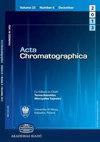Rapid comparison of antitumor chemical constituents and mechanisms between Dendrobium nobile and Dendrobium officinale by UPLC-IT-TOF, network pharmacology and experimental verification
IF 1.7
4区 化学
Q3 CHEMISTRY, ANALYTICAL
引用次数: 0
Abstract
Abstract Dendrobium nobile and Dendrobium officinale as the main varieties of traditional Chinese medicine Dendrobium are widely used in clinic. The study aimed to systematically explore chemical constituents and their antitumor effect of D. nobile and D. officinale by ultra-performance liquid chromatography coupled with ion trap time-of-flight mass spectrometry (UPLC-IT-TOF), network pharmacology and cancer cell experiments. D. nobile extract and D. officinale extract could significantly inhibit the proliferation of human lung cancer A549 cells, human liver cancer HepG2 cells and human breast cancer MCF-7 cells in the dose-dependent manner ( P < 0.05), the antitumor effect of D. officinale extract was stronger than that of D. nobile extract at the same drug concentration. A total of 40 chemical constituents of D. nobile and D. officinale including phenanthrenes, bibenzyls and other types of compounds had been identified by UPLC-IT-TOF, LCMSsolution and MetID software according to retention times, accurate mass, MS n fragmentation, reference compounds and natural product databases. Phenanthrenes with good antitumor activity were mainly present in D. nobile , bibenzyls were the main compounds of D. officinale . Integrated networks of Herb-Compounds-Targets-Cancer revealed that gigantol, moscatilin, tristin, moscatin and densiflorol B were regarded as key antitumor compounds of D. nobile and D. officinale , D. nobile and D. officinale shared 7 targets accounting for 70% of the antitumor core targets, more than half of their antitumor KEGG pathways were similar. The results of molecular docking and western blotting experiments indicated that the antitumor mechanisms of D. nobile and D. officinale may be through inhibiting PI3K-Akt and HIF-1α signaling pathways.利用UPLC-IT-TOF、网络药理学和实验验证快速比较铁皮石斛和铁皮石斛抗肿瘤化学成分及其作用机制
摘要石斛和铁皮石斛作为中药材的主要品种,在临床上应用广泛。本研究旨在通过超高效液相色谱-离子阱飞行时间质谱(UPLC-IT-TOF)、网络药理学和肿瘤细胞实验等方法,系统地探索金牛花和officinale的化学成分及其抗肿瘤作用。丹参提取物和officinale提取物能显著抑制人肺癌A549细胞、人肝癌HepG2细胞和人乳腺癌MCF-7细胞的增殖,且呈剂量依赖性(P <0.05),在相同药物浓度下,铁皮石斛提取物的抗肿瘤作用强于铁皮石斛提取物。采用UPLC-IT-TOF、LCMSsolution和MetID软件,根据保留时间、精确质量、质谱和碎片化度、参比化合物和天然产物数据库,鉴定了白莲草和officinale的40种化学成分,包括菲类、联苯类等化合物。牛蒡子中主要含有具有良好抗肿瘤活性的菲类化合物,联苯类化合物是牛蒡子的主要成分。草药-化合物-靶点-肿瘤的整合网络显示,巨巨醇、mosscatin、tristin、moscatin和密花醇B被认为是金针菇和金针菇的关键抗肿瘤化合物,金针菇和金针菇共有7个靶点,占抗肿瘤核心靶点的70%,它们的抗肿瘤KEGG通路有一半以上相似。分子对接和western blotting实验结果表明,牛蒡子和officinale的抗肿瘤机制可能是通过抑制PI3K-Akt和HIF-1α信号通路实现的。
本文章由计算机程序翻译,如有差异,请以英文原文为准。
求助全文
约1分钟内获得全文
求助全文
来源期刊

Acta Chromatographica
化学-分析化学
CiteScore
4.00
自引率
0.00%
发文量
55
审稿时长
2.3 months
期刊介绍:
Acta Chromatographica
Open Access
Acta Chromatographica publishes peer-reviewed scientific articles on every field of chromatography, including theory of chromatography; progress in synthesis and characterization of new stationary phases; chromatography of organic, inorganic and complex compounds; enantioseparation and chromatography of chiral compounds; applications of chromatography in biology, pharmacy, medicine, and food analysis; environmental applications of chromatography; analytical and physico-chemical aspects of sample preparation for chromatography; hyphenated and combined techniques; chemometrics and its applications in separation science.
 求助内容:
求助内容: 应助结果提醒方式:
应助结果提醒方式:


